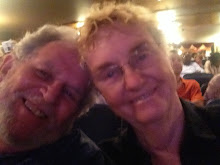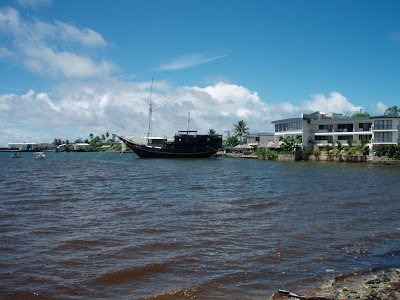Guam is considered the hub of the western Pacific and undeniably Micronesia's most cosmopolitan destination - a true example of the great American melting pot. In addition to the indigenous Chamorros and 'stateside' Americans, Guam boasts large populations of Filipinos, Chinese, Japanese, Koreans, and Micronesian Islanders, as well as a few Vietnamese, Indians, and Europeans. The main source of income on Guam comes, first, from tourism, and second from the American military. The latter is predicted to increase by some 17 000 or more when the US-base on Okinawa closes down in the next five years.
The picture below shows Waikiki-like beaches and upscale hotels that surround Guam’s Tumon Bay. In the distance on the top of the plateau stands the Guam airport. The big jet destined for Honolulu sits at the right end of the airport. Far off in the distance is a major hotel that is just a stone’s throw from the campus of the University of Guam.
 Southern Guam is made up of volcanic hills, which rise to a maximum height of 1,334 feet above sea level. But, measured from its base at the bottom of the Marianas Trench, Mount Lamlam is the highest mountain in the world. Rivers cut through this terrain and high waterfalls abound. The central and northern sections of the island consist of a limestone plateau as high as 600 feet with steep cliffs dropping down to a narrow coastal shelf. The towering cliffs are tunneled with caves formed by the relentless and pounding surf.
Southern Guam is made up of volcanic hills, which rise to a maximum height of 1,334 feet above sea level. But, measured from its base at the bottom of the Marianas Trench, Mount Lamlam is the highest mountain in the world. Rivers cut through this terrain and high waterfalls abound. The central and northern sections of the island consist of a limestone plateau as high as 600 feet with steep cliffs dropping down to a narrow coastal shelf. The towering cliffs are tunneled with caves formed by the relentless and pounding surf.It was on a trip to the southern part of Guam that we sited the ancient Latte stones that are distinctive to Guam and the Mariana Islands.

On a previous trip to Guam, we stopped at a replica of a traditional village, and participated in the crafts activities and the making of artifacts that were typical of local cultural practices. Below, one of the math teachers (in the blue shirt) who worked with Sandy’s projects over the years tries his hand at the making of rope done in the ancient manner.
 Another group of math teachers are shown below during a workshop on Guam. They were making models of traditional Yapese meeting houses with materials that the participants from Yap brought with them to the meeting. All are wearing Yapese lei with their distinctive red, yellow and blue coloring. The gentleman in the yellow shirt is from American Samoa, as is the woman at the opposite end of the row. The woman sitting in front is from Palau as is the man directly behind her. The white haired gentleman is from the Marshall Islands. On many occasions during the ten years of working across the Pacific, Guam was the site of the gathering of the Samoan, Marshallese, Palauan, and Micronesian mathematics teachers Sandy and Sandra came to know and cherish as dear friends.
Another group of math teachers are shown below during a workshop on Guam. They were making models of traditional Yapese meeting houses with materials that the participants from Yap brought with them to the meeting. All are wearing Yapese lei with their distinctive red, yellow and blue coloring. The gentleman in the yellow shirt is from American Samoa, as is the woman at the opposite end of the row. The woman sitting in front is from Palau as is the man directly behind her. The white haired gentleman is from the Marshall Islands. On many occasions during the ten years of working across the Pacific, Guam was the site of the gathering of the Samoan, Marshallese, Palauan, and Micronesian mathematics teachers Sandy and Sandra came to know and cherish as dear friends. Like school systems on many Pacific islands, Guam’s Department of Education is suffering from severe financial constraints, some of which are due to sloppy management of US Office of Education funding. But if you go into classrooms around the island, you will find children active and happy. Indeed, if you didn’t know you were on Guam, you might think the classrooms were on Hawai‘i or Saipan. The boys shown below are busy using geo-boards to discover geometric relationships and patterns.
Like school systems on many Pacific islands, Guam’s Department of Education is suffering from severe financial constraints, some of which are due to sloppy management of US Office of Education funding. But if you go into classrooms around the island, you will find children active and happy. Indeed, if you didn’t know you were on Guam, you might think the classrooms were on Hawai‘i or Saipan. The boys shown below are busy using geo-boards to discover geometric relationships and patterns. Teacher salaries across the region vary widely. In Hawai‘i the starting teacher salary now exceeds $40 000 per year. Guam and Saipan salaries are have not quite reached the $40 000 threshold yet. On the FSM states, salaries might be as low as $8000 per year, and range up to around $18 000. As a point of comparison with other states and territories, the Governors of the FSM states have salaries in the $25 000 to $35 000 range.
Teacher salaries across the region vary widely. In Hawai‘i the starting teacher salary now exceeds $40 000 per year. Guam and Saipan salaries are have not quite reached the $40 000 threshold yet. On the FSM states, salaries might be as low as $8000 per year, and range up to around $18 000. As a point of comparison with other states and territories, the Governors of the FSM states have salaries in the $25 000 to $35 000 range.Yet expenses on these islands are as high if not higher than on Hawai‘i or the mainland. Gas on the Marshall Islands was $5.00 per gallon, the same on Kosrae, and on each of those islands there was one or at most two gas stations. On Kosrae, the station was only open 5 hours each weekday, and closed on the weekends. On Pohnpei gas dropped to $3.90 per gallon with lots of gas stations, but on Chuuk it was back up to $5.00 with just one station operational. Guam, Saipan and Palau were all about the same, $3.75 per gallon with lots of stations. On Yap, the price was $9.00 per gallon if the rental car was returned with less than a full tank, which could only be filled at one station that opened for only 4 hours per day.
But what the islands of the Pacific may experience in terms of financial challenges, they more than make up in terms of beauty, none more so than the splendid and dynamic sunsets one witnesses on small, remote Pacific islands. The picture below is just one example of such a sunset that we took while sitting on the lanai bar of our hotel on Guam.
 As we prepared to fly out of Guam, heading home to Honolulu, we experienced ‘chicken skin’ at the many wonderful memories we have of Micronesian people smiling broadly and exclaiming excitedly as they tried on the readings glasses we shared across the islands. Our very appearance at the arrival gate of many FSM airports signaled the ‘coconut telegraph’ to go into high gear: “the Dawsons have come, and they have glasses”. The PREL service center offices would receive phone calls inquiring about the glasses long before we had been able to drive from the airport to the office. Even when departing some of the islands, the security people who manually go through all the luggage would quietly ask, when they got to the suitcase full of glasses, if they could have a pair of glasses for their mom, or their grandma, or their auntie, or their uncle, hardly ever for themselves, even though some of those agents were squinting to read our names in our passports. Those of you who contributed to the collection of glasses we carried with us should feel justifiably happy about the joy and pleasure your contributions brought to peoples all across the Pacific. In particular, Lannie Kanevsky from Vancouver, Canada found 1200 pairs of reading glasses for sale on eBAy, purchased them, and sent them to us for sharing across Micronesia. Mahalo plenty, Lannie.
As we prepared to fly out of Guam, heading home to Honolulu, we experienced ‘chicken skin’ at the many wonderful memories we have of Micronesian people smiling broadly and exclaiming excitedly as they tried on the readings glasses we shared across the islands. Our very appearance at the arrival gate of many FSM airports signaled the ‘coconut telegraph’ to go into high gear: “the Dawsons have come, and they have glasses”. The PREL service center offices would receive phone calls inquiring about the glasses long before we had been able to drive from the airport to the office. Even when departing some of the islands, the security people who manually go through all the luggage would quietly ask, when they got to the suitcase full of glasses, if they could have a pair of glasses for their mom, or their grandma, or their auntie, or their uncle, hardly ever for themselves, even though some of those agents were squinting to read our names in our passports. Those of you who contributed to the collection of glasses we carried with us should feel justifiably happy about the joy and pleasure your contributions brought to peoples all across the Pacific. In particular, Lannie Kanevsky from Vancouver, Canada found 1200 pairs of reading glasses for sale on eBAy, purchased them, and sent them to us for sharing across Micronesia. Mahalo plenty, Lannie.The sharing of the 1200+ pairs of glasses took place during the past year, not just by us, but also by PREL employees who transported the glasses in their suitcases as they headed west across the Pacific.
And so ends our travels across Micronesia: traversing five time zones as well as a day change in the space of 36 hours will no doubt have its effects on our aging bodies, but, you know, we don’t mind that part at all because the pleasure we get from our associations with all those wonderful Micronesian people. That is well worth a bit of lost sleep and tired bodies.
By the way, the purpose of the trip--to identify a set of folks to work on the new Macimise Project--was a huge success. Indeed, there are more applicants than there are spaces available with the Project. Such interest bodes well for the future of maths education on the Micronesian Islands as the Project should produce university graduates with Masters Degrees (10-12) and Doctorates (8-10).
Aloha and Mahalo till next time…Sandra & Sandy











































